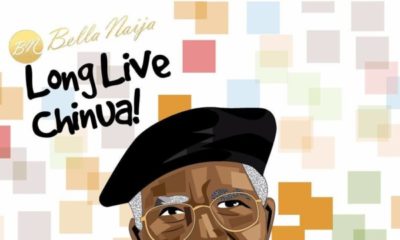Features
Agatha Odigie: BRT Buses, Akara, Brazilian Hair & Rio 2016!
 Firstly, belatedly though, let me join the teeming number of proud Nigerians in saluting our contingent to the Rio 2016 Paralympics where Team Nigeria with her stellar performance shone like a million stars with a formidable medal haul.
Firstly, belatedly though, let me join the teeming number of proud Nigerians in saluting our contingent to the Rio 2016 Paralympics where Team Nigeria with her stellar performance shone like a million stars with a formidable medal haul.
Asides the 2016 Olympics and of course the ubiquitous Brazilian weaves (which we cannot get enough of); Brazil occupies a key position in West African history for both good and bad reasons. Brazil accounted for roughly forty percent of the African slaves brought to the Americas during the Atlantic slave trade with most of them processed at Bahia before being sent off to plantations across the country. Centuries after the slave trade, the Yoruba influence is still heavily felt in Bahia, where their dialect is a blend of Portuguese and Yoruba. Deities such as Orunmila, Obatala, Ogun, Sango, Obatala, etcetera are also worshipped. Babalawos nko? Dem dey there too!
Even local delicacies are well represented, take for instance the utterly scrumptious fried bean cakes called ‘akara’ here, in Bahia, ask for acaraje instead!
In his paper ‘The Brazilian House in Nigeria’ written for the Journal of American Folklore, John Michael Vlach says that by the nineteenth century when slavery was abolished, many ex-slaves of Yoruba descent returned to Lagos from Brazil. These Afro-Brazilians as they were then referred to brought with them excellent building skills such as carpentry and masonry. These skills found expressions in the construction of public edifices such as the Central Mosque, Shitta Bay Mosque and the Holy Cross Cathedral. Surnames such as da Silva, da Costa and Soares were commonplace with the Afro Brazilians who ‘carved’ out the Brazilian quarters known as Popo Aguda located around Campos Square in central Lagos Island. Streets there were named after the more prominent Brazilian settlers such as Pedro, Joseph and Bamgboshe. In such areas, the architecture spoke a common language, characterized by one storey buildings referred to as ‘Ile Petesi’ or ‘upstairs house’. These building facades were lavishly adorned with strong decorative motifs which often bordered on the extravagant and were characteristic of the Baroque era.
You see, in architecture and urban planning, ‘green, and not orange has been the new black’ for a long time – apologies to Uzo Aduba and the other cast of the popular television series. Sustainability is now synonymous with design. For decades, a particular Brazilian city has been considered a jewel in urban planning. In a 2007 international magazine survey, the city placed third in the 15 Green Cities’ of the world. American Reader’s Digest magazine rated it as the best Brazilian City to inhabit. Of recent, it was recommended by UNESCO as a model city for the reconstruction of the war devastated cities of Afghanistan. What manner of city is this? Welcome to Curitiba, the capital of the predominantly agrarian state of Parana in Brazil and one of the host cities of the 2014 FIFA World Cup.
The foundation of Curitiba’s sustainable urban development greatness was laid in 1968 with the adoption of the Curitiba Master Plan. The master plan was prepared by a team from Architecture School of the Federal University of Paraná led by Jaime Lerner, an architect who later became a three time mayor of Curitiba and president of the IUA- International Union of Architects. With political will now at his disposal as mayor, Lerner, commenced the implementation of the 1968 Curitiba Master Plan using innovative and sustainable solutions.
Now let’s get to the Lagos-Curitiba/Brazil connection. Jamie Lerner utilized unorthodox reforms in Curitiba’s transport sector with the introduction of the Rede Integrada de Transporte or the Bus Rapid Transport (BRT) System for which Curitiba continues to garner world wide acclaim and accolades. Lerner ditched earlier plans for subways or heavy rails which upon closer scrutiny would cost ten times the amount for light rails which in turn cost ten times a bus system.
With the dedicated bus lanes, these buses would run at speeds comparable to the light rail. The 270 capacity custom made bi-articulated (three section) Volvo buses accounts for over 70% of daily travel. It is estimated that 1100 buses make 12500 trips ferrying more than 1, 600,000 passengers daily. This has evidently led to reduced vehicular traffic and atmospheric pollution. An interesting feature of the public transport system is the bus station. Curitiba’s conventional bus stations or transit stops were remodelled in 1991 to become modern raised platforms of open ended glass tubes mimicking the ambience of a train station. The 357 tube stations that dot Curitiba’s landscape have provisions for handicap access.
So now you see where the Asiwaju Bola Ahmed Tinubu, the initiator of the BRT got the idea from? The Lagos Bus Rapid Transport (BRT) System, a 22km stretch from Mile 12 through Ikorodu Road and Funsho Williams Avenue up to CMS was commissioned on March 17 2008. According to the Lagos Metropolitan Area Transport Authority (LAMATA), its BRT System uses 220 buses to move more than 200, 000 passengers daily.
Asides from the introduction of the BRT System, Jaime Lerner also implemented social reforms, like the exchange programme whereby waste from the slums are brought by the residents to designated collection points in exchange for groceries and BRT tickets thus ensuring that the slums are kept clean. Another radical socio- economical measure implemented was the use of ‘municipal sheep’ instead of the conventional tractors to keep the vegetation of Curitiba’s vast expanse of parks under control. The parks were created in areas susceptible to flooding. Proceeds from the sale of the municipal sheep wool are used to fund children’s programmes. The list of Curitiba’s sustainable urban, geographical and social reforms which were initiated by Jaime Lerner in 1971 and remain till date is seemingly endless with the citizenry reaping the benefits- low crime rates, absence of street gangs, better quality of living, healthier environment, etcetera.
Perhaps, sometime in the foreseeable future, besides utilization of the BRT (which has proven fairly successful in a mega city like Lagos), other geographical and social reforms like those used in Curitiba with positive impacts and minimal disruption to the urban environment would be implemented here in Nigeria.
Photo Credit: Dreamstime


























